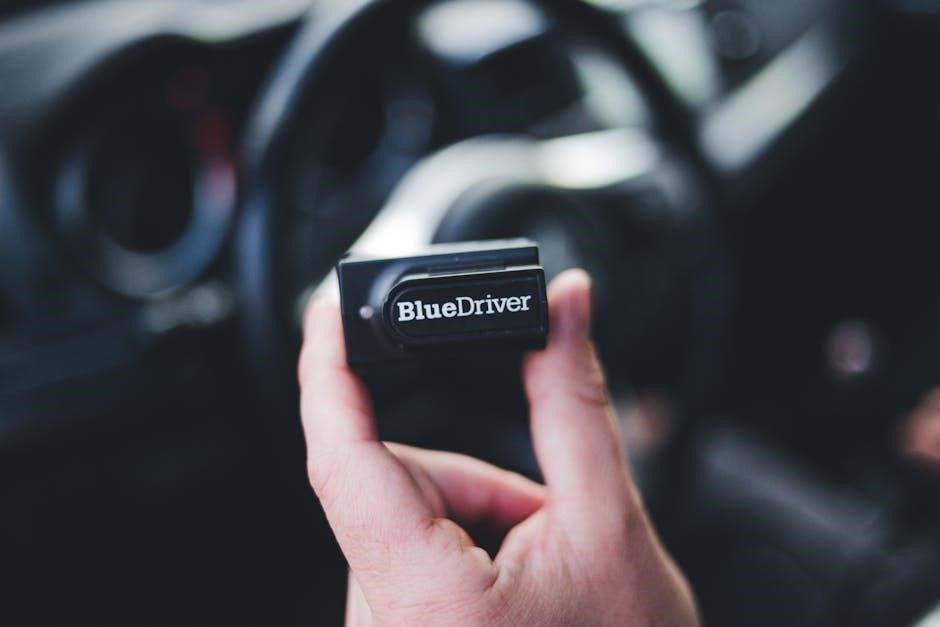honeywell 1952 scanner manual pdf
The Honeywell Xenon XP 1952 scanner is a versatile, high-performance area imaging solution designed for efficient 1D and 2D barcode scanning across various industries, supported by a comprehensive manual for optimal use.
1.1 Overview of the Honeywell Xenon XP 1952 Series
The Honeywell Xenon XP 1952 series is a line of advanced area-imaging scanners designed for high-performance barcode scanning in various industries. Available in models such as the 1952g and 1952h, these scanners are known for their versatility and reliability. The series supports both 1D and 2D barcode scanning, making them suitable for retail, healthcare, and industrial applications. With cordless and corded options, the scanners offer flexibility in operation. The 1952 series is also compatible with multiple devices and systems, ensuring seamless integration into existing workflows. The Honeywell Xenon XP 1952 scanners are built with durable construction and advanced imaging technology, providing accurate and efficient scanning experiences. The manual for the Honeywell 1952 scanner is essential for understanding its features, setup, and troubleshooting, ensuring users can maximize its capabilities.
- Supports 1D and 2D barcode scanning.
- Available in cordless and corded models.
- Compatible with multiple devices and systems.
- Built with advanced area-imaging technology.
1.2 Key Features of the Honeywell 1952 Scanner
The Honeywell Xenon XP 1952 scanner boasts several key features that make it a robust solution for barcode scanning. It utilizes advanced area-imaging technology, enabling accurate scanning of both 1D and 2D barcodes. The scanner is available in cordless and corded models, offering flexibility for different work environments. With compatibility across various devices and systems, it seamlessly integrates into existing workflows. The manual trigger mode allows for precise control over scanning operations. Additionally, the scanner supports easy linking to charge bases, ensuring efficient battery management. Its durable design and intuitive operation make it suitable for demanding applications. The Honeywell 1952 scanner also provides clear charge status feedback, helping users maintain productivity. These features, combined with comprehensive guidance from the Honeywell 1952 scanner manual, ensure optimal performance and ease of use.
- Advanced area-imaging technology for accurate scanning.
- Cordless and corded operation modes.
- Compatibility with multiple devices and systems.
- Manual trigger mode for precise scanning control.
- Efficient battery management with charge base linking.
1.3 Importance of the Honeywell 1952 Scanner Manual
The Honeywell 1952 scanner manual is an essential resource for users, providing detailed guidance on setup, operation, and troubleshooting. It ensures proper installation and configuration, helping users unlock the scanner’s full potential. The manual offers step-by-step instructions for connecting the scanner to devices, installing software, and optimizing settings. It also covers advanced features like area-imaging technology and cordless operation. Troubleshooting sections help resolve common issues, minimizing downtime. Additionally, the manual includes safety precautions and maintenance tips to extend the scanner’s lifespan. By following the manual, users can maximize efficiency and accuracy in their scanning operations. Accessing the Honeywell 1952 scanner manual PDF ensures users have all the information needed to operate the device effectively.
- Provides setup and configuration guidance.
- Includes troubleshooting solutions.
- Explains advanced features and maintenance.
- Ensures safe and optimal scanner operation.

Installation and Setup of the Honeywell 1952 Scanner
Installing the Honeywell 1952 scanner involves unboxing, connecting to a device, and installing software. Follow the manual for step-by-step guidance to ensure proper setup and functionality.
- Unbox and identify hardware components.
- Connect the scanner to a computer or device.
- Install necessary drivers and software.
2.1 Unboxing and Hardware Components
When unboxing the Honeywell 1952 scanner, you’ll find the scanner itself, a charge base, a communication base, a power supply, a USB cable, and a quick start guide. The scanner is lightweight and ergonomic, designed for comfortable use. The charge base allows for easy recharging, while the communication base enables wireless or wired connectivity. The power supply ensures reliable power, and the USB cable facilitates direct connection to a computer. The quick start guide provides initial setup instructions. Refer to the manual for detailed descriptions of each component and their functions. Proper identification of hardware is essential for seamless installation and operation. Ensure all items are included and undamaged before proceeding with setup.
- Scanner device with area imaging technology.
- Charge base for recharging the scanner.
- Communication base for data transmission.
- Power supply and USB cable for connectivity.
- Quick start guide for initial setup instructions.
2.2 Connecting the Scanner to a Computer or Device

Connecting the Honeywell 1952 scanner to a computer or device is straightforward and supports both wired and wireless configurations. For wired connections, use the provided USB cable to link the scanner directly to your computer. Ensure the scanner is powered on and properly recognized by the system. For wireless connectivity, pair the scanner with the communication base, which supports Bluetooth or radio frequency (RF) technology. The charge base also acts as a docking station, enabling seamless communication when the scanner is placed on it. Refer to the manual for specific pairing instructions, as the process may vary depending on the device or system you are using. Proper connectivity ensures reliable data transmission and optimal scanning performance.
- Use the USB cable for a direct wired connection.
- Pair the scanner with the communication base for wireless operation.
- Ensure the scanner is powered on during the connection process.
- Refer to the manual for detailed pairing instructions.
2.3 Installing the Necessary Software and Drivers
Installing the required software and drivers for the Honeywell 1952 scanner ensures optimal performance and compatibility with your system. Begin by visiting the Honeywell website to download the latest drivers and software specific to your scanner model. Follow the on-screen instructions to complete the installation process. Additionally, install Honeywell’s Scanner Software, which provides advanced configuration tools and customization options. Ensure all drivers are updated to maintain compatibility with your operating system. Refer to the manual for detailed steps, as some models may require specific configurations. Proper installation of software and drivers is essential for seamless communication between the scanner and your device, enabling efficient barcode scanning and data transfer.

- Download drivers from the Honeywell website.
- Install Honeywell Scanner Software for advanced features.
- Update drivers regularly for system compatibility.
- Follow manual instructions for specific configurations.

Configuring the Honeywell 1952 Scanner
Configure the Honeywell 1952 scanner by adjusting settings for optimal performance, ensuring compatibility with various devices, and enabling advanced features for seamless barcode scanning experiences.
3.1 Setting Up Communication Modes
To set up communication modes for the Honeywell 1952 scanner, ensure the device is powered on and properly connected to your computer or base. The scanner supports multiple communication modes, including USB, serial, and Bluetooth, allowing flexibility in different environments. For cordless operation, pair the scanner with the charge base by following the linking instructions in the manual. Once connected, the scanner can emulate a keyboard or communicate directly with your system. Manual Trigger Mode can be activated by scanning the appropriate barcode, enabling precise control over scanning operations. Ensure the scanner is configured to match your system’s requirements for seamless integration. Refer to the Honeywell 1952 scanner manual for detailed steps on setting up communication modes and troubleshooting connectivity issues.
3.2 Customizing Scanner Settings for Optimal Performance
Customizing the Honeywell 1952 scanner settings ensures optimal performance tailored to your specific needs. Adjustments can be made to sensitivity, brightness, and contrast to enhance barcode readability. The scanner also supports data formatting, allowing you to add prefixes or suffixes to scanned data. For advanced customization, use the Honeywell software tools provided in the manual to configure settings such as scan delay, timeout, and beeper volume. Additionally, the scanner can be programmed to capture images for applications requiring visual verification. Regularly updating the scanner’s firmware, as outlined in the manual, ensures access to the latest features and improvements. Refer to the Honeywell 1952 scanner manual for step-by-step guidance on customizing settings to maximize efficiency and accuracy in your scanning operations.
3.3 Understanding the Manual Trigger Mode
The Manual Trigger Mode on the Honeywell 1952 scanner allows users to control scanning operations manually, ensuring precise and intentional barcode scanning. To activate this mode, scan the specific barcode provided in the manual, which disables automatic scanning. This feature is particularly useful in environments where accidental scans need to be avoided. Once in Manual Trigger Mode, the scanner will only activate when the trigger is pressed, providing better control over scanning processes. The manual also guides users on how to link the scanner to the charge base and troubleshoot common issues related to trigger functionality. By following the instructions in the Honeywell 1952 scanner manual, users can optimize their scanning experience and ensure efficient operation in various applications.
Using the Honeywell 1952 Scanner for Barcode Scanning
The Honeywell 1952 scanner efficiently scans 1D and 2D barcodes, offering precise and rapid performance. Its user-friendly design ensures seamless integration into various workflows, supported by comprehensive manual guidance for optimal scanning experiences.
4.1 Scanning 1D and 2D Barcodes
The Honeywell Xenon XP 1952 scanner excels in scanning both 1D and 2D barcodes, ensuring high accuracy and efficiency. Its advanced area imaging technology captures barcodes quickly, even in challenging conditions. The scanner supports a wide range of barcode symbologies, making it versatile for various applications. For 1D barcodes, it reliably decodes linear codes, while for 2D barcodes, it handles matrix codes with ease. The manual provides detailed guidance on optimizing settings for different barcode types, ensuring seamless scanning experiences. Whether in retail, healthcare, or logistics, the Honeywell 1952 scanner delivers consistent performance, making it a reliable choice for diverse scanning needs.

4.2 Linking the Scanner to the Charge Base
Linking the Honeywell Xenon XP 1952 scanner to its charge base is a straightforward process that ensures seamless communication and charging. The scanner, particularly models like the CCB01-010BT-BF, must be in Manual Trigger Mode to establish a connection. Once the base is powered on, the scanner automatically detects and pairs with it. The manual provides step-by-step instructions for linking, including any necessary settings adjustments. Proper pairing ensures efficient charging and reliable performance. The LED indicators on both the scanner and base provide visual feedback, confirming a successful connection. Regularly linking the scanner to the charge base helps maintain optimal functionality and extends the device’s lifespan. Always refer to the manual for specific pairing instructions tailored to your scanner model.
4.3 Troubleshooting Common Scanning Issues
Troubleshooting the Honeywell Xenon XP 1952 scanner involves addressing common issues like poor barcode reading, connectivity problems, or charging difficulties. Ensure the scanner lens is clean and free from smudges, as dirt can obstruct the imaging sensor. For connectivity issues, verify that the scanner is properly paired with the charge base and that the base is powered on. If the scanner fails to link, restart both devices and attempt pairing again. Battery-related problems can often be resolved by charging the scanner for at least 30 minutes. If issues persist, consult the manual for advanced troubleshooting steps, such as resetting the scanner or updating its firmware. Regular maintenance, like cleaning and updating software, helps prevent recurring problems and ensures optimal performance.
Maintenance and Care of the Honeywell 1952 Scanner
Regularly clean the lens and exterior to ensure optimal performance. Store the scanner in a dry, cool place to prevent damage. Avoid extreme temperatures and physical stress.
5.1 Cleaning the Scanner Lens and Exterior
Regular cleaning of the Honeywell 1952 scanner lens and exterior is essential for maintaining its performance and longevity. Use a soft, dry cloth to gently wipe the lens, removing dirt or smudges. For stubborn marks, lightly dampen the cloth with water, but avoid harsh chemicals or abrasive materials that could damage the surface. The exterior can be cleaned with a mild detergent solution, ensuring no moisture seeps into the device. Avoid touching the lens with bare hands, as oils can leave residue. Cleaning should be done periodically, especially in environments with high dust or dirt exposure. Proper maintenance ensures accurate barcode scanning and prevents wear and tear. Always refer to the Honeywell 1952 scanner manual for detailed cleaning instructions to avoid voiding the warranty or causing damage.
5.2 Charging and Battery Maintenance
Proper charging and battery maintenance are crucial for ensuring the longevity and performance of the Honeywell 1952 scanner. Use only the approved Honeywell charger and cable to avoid damage to the device. The scanner can be charged via the provided cradle or through a USB connection. Avoid overcharging, as it may reduce battery lifespan. When not in use for extended periods, store the scanner with a partially charged battery (around 50%) to prevent deep discharge. Regularly update the firmware during charging to ensure optimal performance. If the battery is completely drained, allow it to charge for at least 30 minutes before use. For detailed charging instructions and battery care tips, refer to the Honeywell 1952 scanner manual. Proper maintenance ensures reliable operation and extends the scanner’s service life.
5.3 Updating Firmware for Enhanced Performance
Regular firmware updates are essential to ensure the Honeywell 1952 scanner operates at peak performance. These updates often include bug fixes, feature enhancements, and compatibility improvements. To update the firmware, connect the scanner to a computer using the provided USB cable and access the Honeywell software tool. Follow the on-screen instructions to download and install the latest firmware version. Ensure the scanner remains connected throughout the process to avoid interruptions. Once updated, the scanner will restart automatically. Refer to the Honeywell 1952 scanner manual for detailed step-by-step guidance. Keeping the firmware up to date ensures optimal scanning accuracy, improved functionality, and compatibility with the latest systems. Regular updates also help maintain security and reliability, making it a critical part of scanner maintenance.
Advanced Features of the Honeywell 1952 Scanner
The Honeywell 1952 scanner features area imaging technology, enabling high-speed scanning of 1D and 2D barcodes. It supports cordless and corded modes, offering flexibility in various environments, and is compatible with multiple devices and systems for seamless integration.
6.1 Area Imaging Technology

The Honeywell Xenon XP 1952 scanner incorporates advanced area imaging technology, enabling it to capture entire images of barcodes rather than scanning them sequentially. This technology allows for rapid and accurate decoding of both 1D and 2D barcodes, even if they are damaged or poorly printed. The scanner’s area imaging capability ensures high-speed performance, making it ideal for demanding environments such as retail, healthcare, and logistics. By capturing a complete image of the barcode, the scanner reduces the need for multiple scans, improving efficiency and user experience. This feature is particularly beneficial for reading barcodes on curved or irregular surfaces, ensuring reliable data capture. The manual provides detailed guidance on optimizing the area imaging settings for specific applications, ensuring users can maximize the scanner’s performance in their operational settings.

6.2 Cordless and Corded Operation Modes
The Honeywell Xenon XP 1952 scanner offers both cordless and corded operation modes, providing flexibility for various applications. In cordless mode, the scanner operates via a rechargeable battery, enabling wireless scanning and greater mobility. This is ideal for environments where freedom of movement is essential, such as retail or healthcare settings. The corded mode, on the other hand, ensures continuous power for fixed scanning stations, reducing downtime and dependency on battery life. The manual provides detailed instructions on switching between modes, pairing the scanner with its charge base, and managing battery maintenance. This dual functionality allows users to adapt the scanner to their specific needs, ensuring efficient performance in both mobile and stationary workflows. The ability to toggle between modes enhances versatility, making the Xenon XP 1952 suitable for a wide range of scanning tasks.
6.3 Compatibility with Various Devices and Systems
The Honeywell Xenon XP 1952 scanner is designed to integrate seamlessly with a wide range of devices and systems, ensuring versatility across different environments. It supports connection to Windows, iOS, and Android platforms, making it suitable for both mobile and fixed scanning applications. The scanner is also compatible with IBM POS systems and Apple Macintosh computers, as detailed in the manual. This broad compatibility allows users to pair the scanner with existing infrastructure, minimizing setup challenges. Additionally, the Xenon XP 1952 can emulate keyboard wedge and USB HID interfaces, further enhancing its adaptability. The manual provides step-by-step guidance on configuring the scanner for various devices, ensuring smooth integration and optimal performance. This flexibility makes the Honeywell Xenon XP 1952 an ideal choice for diverse industries, from retail to healthcare.

Compliance and Safety Information
The Honeywell Xenon XP 1952 scanner adheres to regulatory standards, ensuring safety and environmental compliance. Proper usage guidelines and disposal methods are outlined in the manual for user safety.
7.1 Regulatory Compliance and Certifications
The Honeywell Xenon XP 1952 scanner is designed to meet global regulatory standards, ensuring compliance with safety and environmental regulations. It holds certifications such as FCC, CE, and UL, guaranteeing adherence to international standards. The scanner’s model, CCB01-010BT, is specifically noted for its compliance with electromagnetic compatibility and safety requirements. The manual provides detailed information on certifications, enabling users to verify the scanner’s adherence to regional regulations. Compliance ensures the device operates safely and efficiently in various environments, including healthcare and retail settings. By meeting these standards, the Honeywell Xenon XP 1952 scanner demonstrates Honeywell’s commitment to quality and sustainability, making it a reliable choice for professional applications. The certifications also assure users of minimal environmental impact, aligning with global sustainability goals.
7.2 Safety Precautions for Proper Usage
To ensure safe and effective use of the Honeywell Xenon XP 1952 scanner, follow these precautions: Use only approved chargers and cables to avoid damage or fire hazards. Avoid exposing the scanner to extreme temperatures, moisture, or physical stress. Handle the device carefully to prevent drops or impacts that could damage internal components. Keep the scanner out of reach of children and unauthorized users. When charging, place the scanner on a stable, heat-resistant surface. Do not modify or tamper with the device, as this may void the warranty or pose safety risks. Always follow the instructions in the manual for proper operation, especially when using the manual trigger mode. Regularly inspect the scanner for signs of wear or damage and address issues promptly. Proper adherence to these guidelines ensures safe and reliable performance of the Honeywell Xenon XP 1952 scanner in various environments.
7.3 Environmental Considerations for Disposal
Proper disposal of the Honeywell Xenon XP 1952 scanner is essential to minimize environmental impact. The device contains electronic components and batteries, which may be hazardous if not disposed of correctly. Users should adhere to local regulations and guidelines for recycling electronic waste. Do not incinerate or dispose of the scanner in regular landfill waste, as this can release harmful substances. Instead, utilize authorized electronic waste recycling centers that specialize in handling such devices responsibly. Honeywell encourages eco-friendly practices and provides resources in the manual for proper disposal methods. By following these guidelines, users can help protect the environment and ensure compliance with sustainability standards. Always prioritize responsible disposal to contribute to a greener future while maintaining adherence to environmental regulations.
The Honeywell Xenon XP 1952 scanner offers efficient and accurate barcode scanning solutions. For detailed guidance, refer to the Honeywell 1952 scanner manual PDF, available on Honeywell’s official website.

8.1 Summary of Key Points
The Honeywell Xenon XP 1952 scanner is a high-performance, versatile solution for 1D and 2D barcode scanning, ideal for various industries. It supports both cordless and corded operations, offering flexibility in use. The scanner features advanced area imaging technology, ensuring accurate and efficient scanning. Proper setup, including linking the scanner to its charge base, is essential for optimal performance. Regular maintenance, such as cleaning the lens and updating firmware, is recommended to maintain functionality. The Honeywell 1952 scanner manual provides detailed guidance on installation, configuration, and troubleshooting. It also covers safety precautions and regulatory compliance. By following the manual, users can maximize the scanner’s capabilities and extend its lifespan. This comprehensive guide is a valuable resource for anyone using the Honeywell Xenon XP 1952 scanner in their operations.
8.2 Accessing the Honeywell 1952 Scanner Manual PDF
The Honeywell Xenon XP 1952 scanner manual PDF is readily available for download from Honeywell’s official website and other authorized online platforms. To access it, visit the Honeywell support page, navigate to the “Downloads” section, and search for the Xenon XP 1952 model. Select the appropriate manual based on your scanner’s specific configuration, such as the 1952g or 1952h variant. Ensure you download the correct version to match your device’s firmware and features. The manual is provided in PDF format for easy viewing and printing. It is essential to use the official Honeywell website or trusted sources to avoid unauthorized or outdated versions. The manual includes detailed instructions for installation, configuration, troubleshooting, and maintenance, making it an indispensable resource for optimal scanner performance and longevity.
